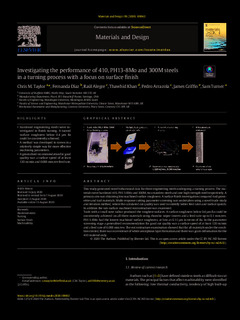Title
Investigating the performance of 410, PH13-8Mo and 300M steelsin a turning process with a focus on surfacefinishAuthor (from another institution)
Other institutions
University of SheffieldUniversidad de Chile
Manchester Metropolitan University
Coventry University (UK)
Version
Published version
Rights
© 2020 The AuthorsAccess
Open accessPublisher’s version
https://doi.org/10.1016/j.matdes.2020.109062Published at
Materials & Design Vol. 195. N. art. 109062, 2020Publisher
Elsevier Ltd.Keywords
Hardened steelsTurning
Surface finish
Machinability
Abstract
This study generated novel behavioural data for three engineering steels undergoing a turning process. The materialswere hardened 410, PH13-8Mo and 300M, two stainless steels and one high strength ste ... [+]
This study generated novel behavioural data for three engineering steels undergoing a turning process. The materialswere hardened 410, PH13-8Mo and 300M, two stainless steels and one high strength steel respectively. A primary aimwas obtaining lowmachined surface roughness. A surface finish investigation compared tool geometries and tool materials.Multi-response cutting parameter screening was undertaken using a novel trade study
and iteration method, where the calculated cut quality was used to identify better feed rates and surface speeds.
In addition the sub-surface machined microstructure was examined.
Tools with a small nose radius produced the roughest surfaces. A surface roughness below 0.4 μm Ra could be consistently achieved on all three materials using rhombic wiper inserts and a feed rate up to 0.1 mm/rev. PH13-8Mo had the lowest machined surface roughness, as low as 0.11 μm in terms of Ra. In the parameter screening stage a generalised recommendation for good cut quality was a surface speed of at least 120 m/min
and a feed rate of 0.088mm/rev. The microstructure examination showed that for all materials under the conditions tested, therewas no evidence ofwhite amorphous layer formation and therewas grain deformation for the 410 material only. [-]
xmlui.dri2xhtml.METS-1.0.item-sponsorship
Tata SteelCollections
- Articles - Engineering [745]
The following license files are associated with this item:






















